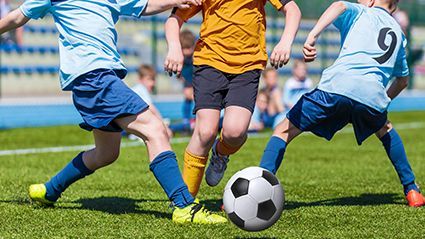TUESDAY, April 13, 2021 (HealthDay News) — Though playing youth sports comes with new pandemic-era precautions and some experts are linking these activities to community spread of COVID-19, many kids are still participating, according to a parent survey.
In the survey, about three-quarters of parents said their child’s teams mostly did the right thing while resuming sports during COVID. Thirteen percent said officials were too strict, and 14% said they were too lenient.
About 1 in 4 parents allowed their kids to play on school, travel or community teams this past fall or winter. That’s roughly the same percentage who gave sports organizations low rankings for enforcing COVID safety guidelines.
“As kids return to playing sports, it’s critical that teams and facilities enforce COVID guidelines to keep players, coaches and families as safe as possible and to reduce community spread,” said Sarah Clark, co-director of the C.S. Mott Children’s Hospital National Poll on Children’s Health at the University of Michigan.
“This is especially important as we have seen recent COVID-19 outbreaks among youth sports teams,” she said in a university news release. “While most families seem confident in their local organization’s safety measures, our report suggests that ensuring compliance with COVID-19 protocols has also been challenging.”
About 1,630 parents of 6- to 18-year-olds responded to the survey about youth sports participation between August 2020 and January 2021.
Roughly a quarter of their 12- to 18-year-olds played sports during that time, as did 21% of 6- to 11-year-olds.
Among parents whose child did not play, 1 in 3 said their child’s sport was canceled, and 1 in 4 said they did not let their child participate due to COVID-related safety concerns.
Most rated their schools or sports league as excellent or good in terms of communication, treating kids fairly and listening to parent concerns. More than 90% said they received information about masks and social distancing, and 80% said they received information about when players should sit out after being exposed to the virus.
Rules on testing were less consistent, with about 59% saying they had received some communication about when players should get tested for COVID.
“As more youth sports resume, our poll suggests that parents will need further direction on whether, when and where their child should get tested,” Clark said. “This is particularly important as cases are rising among younger people.”
Asked what they would do if their child had COVID during the season, 4 in 10 said they would keep them out of play for the number of days specified in team or league guidelines. Half said they would have their child cleared to play by a doctor.
Experts say return to play should be based on severity of infection, preexisting conditions and whether a child still has fever, dizziness, chest pain or fatigue.
Clark said parents should reinforce common sense steps, such as not sharing water bottles or food and using hand sanitizer during breaks. They should set an example by maintaining social distance and wearing masks themselves, she added.
“We know sports provide physical and social health benefits for children and teens and are a valuable part of many students’ school experience,” Clark said.
Unlike many youth activities that have switched to remote format, that’s impossible with sports.
“It’s important that both sports officials and families closely adhere to guidelines that minimize the risk of COVID-19 transmission during practices and competitions,” Clark said.
More information
The U.S. Centers for Disease Control and Prevention has more information on COVID-19.
SOURCE: Michigan Medicine–University of Michigan, news release, April 13, 2021
Copyright © 2025 HealthDay. All rights reserved.

